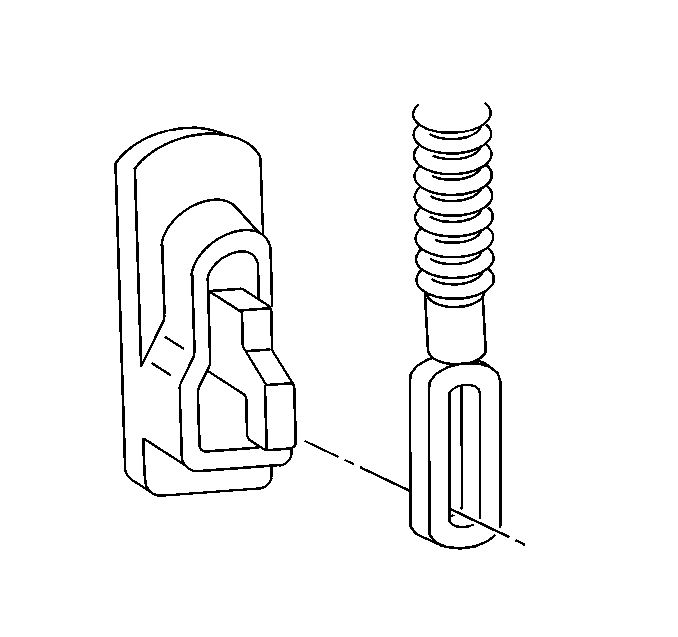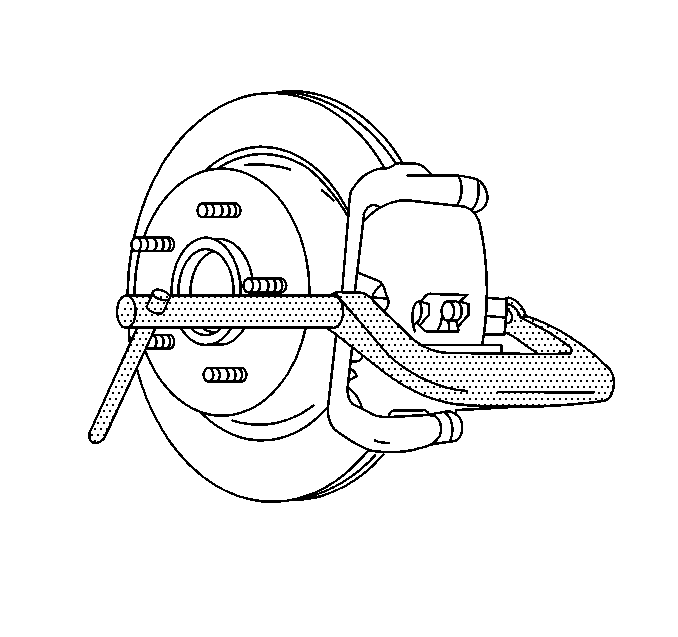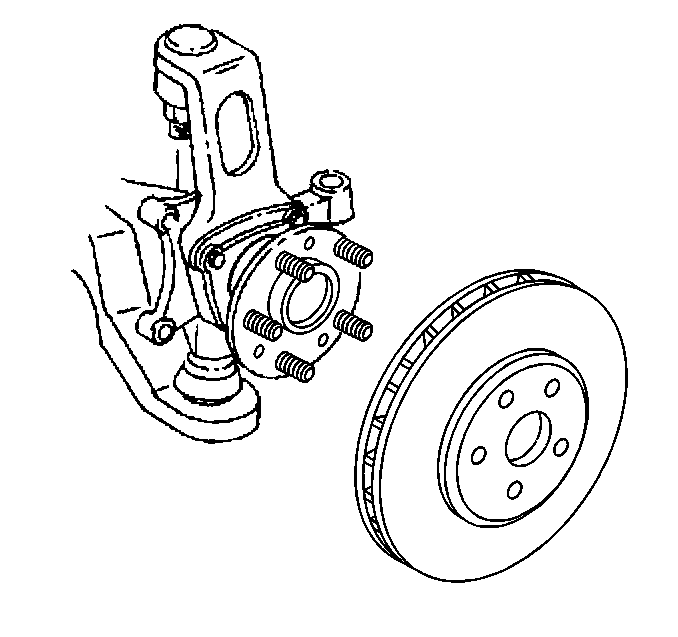Tools Required
Caution: Refer to Brake Dust Caution in the Preface section.
Removal Procedure
- Check to be sure that the park brake is released.
- Raise and support the vehicle. Refer to
Lifting and Jacking the Vehicle
.
- Remove the tire and wheel assembly. Refer to
Tire and Wheel Removal and Installation
.

- Disconnect the park brake cable from the park brake apply lever.

- Install a C-clamp over the body of the brake caliper, with the C-clamp ends against the rear of the caliper body and the outboard disc brake pad.
- Using the C-clamp, compress the piston into the caliper bore just enough to allow the caliper to slide away from the rotor.
- Remove the C-clamp.
Notice: Support the brake caliper with heavy mechanic wire, or equivalent,
whenever it is separated from its mount and the hydraulic flexible brake hose is still connected. Failure to support the caliper in this manner will cause the flexible brake hose to bear the weight of the caliper, which may cause damage to the brake hose and
in turn may cause a brake fluid leak.
- Remove the caliper bracket bolts. Do not disconnect the brake flexible hose bolt.
- Remove the brake caliper and the caliper mounting bracket as an assembly from the suspension knuckle and support the assembly with heavy mechanic's wire, or equivalent. Ensure that there is no tension on the hydraulic brake flexible hose. Refer
to
Rear Brake Caliper Bracket Replacement
.
- Matchmark the position of the brake rotor to the wheel studs.
- Remove the brake rotor. Do not force the rotor off. If the rotor is difficult to remove, ease it off by gently rotating it as you pull outward.

Important: The following service procedure is to be used only if the rear brake rotors cannot be removed without using force.
- If the rear brake cannot be removed, perform the following:
| 12.2. | Insert
J-46277
between the rotor friction surfaces in the vent section of the rotor. DO NOT place the
J-46277
on the rotor friction surface. |
| 12.4. | Inspect the park brake components for the following conditions: |
| • | Bent or broken hold down spring |
| • | Broken, cracked or worn brake shoe lining |
| • | Bent or damaged brake shoe |
| • | Worn, bent or damaged backing plate |
| 12.5. | Replace any defective parts found. |
Installation Procedure
Important: Whenever the brake rotor has been separated from the hub/axle flange, any rust or contaminants should be cleaned from the hub/axle flange and the brake rotor mating surfaces. Failure to do this may result in excessive
assembled lateral runout (LRO) of the brake rotor, which could lead to brake pulsation.
- Using the
J 42450-A
, thoroughly clean any rust or corrosion from the mating surface of the hub/axle flange.
- Using the
J 41013
, thoroughly clean any rust or corrosion from the mating surface and mounting surface of the brake rotor.
- Inspect the mating surfaces of the hub/axle flange and the rotor to ensure that there are no foreign particles or debris remaining.

- Connect the park brake cable to the park brake lever.
- Adjust the clearance of the park brake shoe to the drum-in-hat portion of the brake rotor. Refer to
Park Brake Adjustment
.

- Install the brake rotor to the hub/axle flange. Use the matchmark made prior to removal for proper orientation to the flange.
- If the brake rotor was removed and installed as part of a brake system repair, measure the assembled lateral runout (LRO) of the brake rotor to ensure optimum performance of the disc brakes. Refer to
Brake Rotor Assembled Lateral Runout Measurement
.
- If the brake rotor assembled LRO measurement exceeds the specification, bring the LRO to within specifications. Refer to
Brake Rotor Assembled Lateral Runout Correction
.
- Install the brake caliper and the brake caliper bracket as an assembly to the suspension knuckle. Refer to
Rear Brake Caliper Bracket Replacement
.
- Install the tire and wheel assembly. Refer to
Tire and Wheel Removal and Installation
.
- Lower the vehicle.
- If the brake rotor was refinished or replaced, or if new brake pads were installed, burnish the pads and rotors. Refer to
Brake Pad and Rotor Burnishing
.





